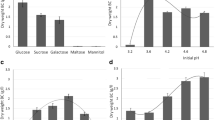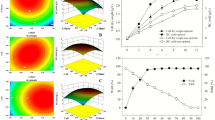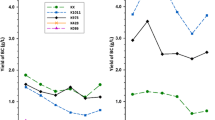Abstract
A bacterial cellulose (BC) synthesizing strain (Gluconacetobacter xylinus ZHCJ618) was isolated from kombucha and selected as the species for commercial applications owing to its high phenotypic stability and sustainable production capacity of 7.56 ± 0.57 g/L under static culturing conditions and 8.31 ± 0.79 g/L under shaking conditions. The morphological, physiological and biochemical characteristics of the strain were similar to those of Gluconacetobacter genus. The 16S rDNA sequence homologies with G. xylinus NCIB 11664 reached 99%, showing that the isolated strain can be identified as G. xylinus. The material properties of BC were studied by fourier transform infrared spectroscopy, scanning electronic microscopy, X-ray diffraction, thermogravimetric analysis, and tensile test. The results showed that BC synthesized under static conditions exhibited stronger tear strength, higher crystallinity, superior waterhold and rehydration rate than BC synthesized under shaking conditions.





Similar content being viewed by others
References
Barud HS, Rodrigo TR, Marques FC, Lustri WR, Messaddeq Y, Ribeiro SJL. Antimicrobial Bacterial Cellulose-Silver Nanoparticles Composite Membranes. J. Nanomater. 8: 1–8 (2011)
Cai ZJ, Yang G. Bacterial cellulose/collagen composite: Characterization and first evaluation of cytocompatibility. J. Appl. Polym. Sci. 120: 2938–2944 (2011)
Saska S, Teixeir LN, Oliveira PTD, Messaddeq Y. Bacterial cellulose-collagen nanocomposite for bone tissue engineering. J. Mater. Chem. 22: 22102–22112 (2012)
Klemm D, Kramer F, Moritz S, Lindstrom T, Ankerfors M, Gray D, Dorris A. Nanocelluloses: a new family of nature-based materials. Angew. Chem. Int. Ed. 50: 5438–5466 (2011)
Gao C, Yan T, Dai K, Wan Y. Immobilization of gelatin onto natural nanofibers for tissue engineering scaffold applications without utilization of any crosslinking agent. Cellulose. 19: 761–768 (2012)
Liu B, Zhang Z, Huang K. Cellulose sulfuric acid as a bio-supported and recyclable solid acid catalyst for the synthesis of 5-hydroxymethylfurfural and 5-ethoxymethylfurfural from fructose. Cellulose. 20: 2081–2089 (2013)
Eichhorn SJ, Dufresne A, Aranguren M, Marcovich NE, Capadona JR, Rowan SJ, Weder C, Thielemans W, Roman M, Renneckar S. Review: Current international research into cellulose nanofibres and nanocomposites. J. Mater. Sci. 45: 1–33 (2010)
Bungay HR, Serafica. Production of microbial cellulose. U.S. Patent, 6,071,727 (1997)
Xie JJ, Hong F. Recent Progress in fermentation feedstocks of bacterial cellulose. Journal of Cellulose Science and Technology. 19: 68–77 (2011) (in Chinese)
Stapleton PC, Dobson ADW. Carbon repression of cellobiose dehydrogenase production in the white rot fungus trametes versicolor is mediated at the level of gene transcription. FEMS Microbiol. Lett. 221: 167–172 (2003)
Serafica G, Mormino R, Bungay H. Inclusion of solid particles in bacterial cellulose. Appl. Microbiol. Biotechnol. 58: 756–760 (2002)
Mormino R. Incorporation of common cellulose into bacterial cellulose. Ph. Thesis, Rensselaer Polytechnic Institute, Troy, N. Y.
Shen XK. Review of kombucha research progress. Ind. Sci. Tribune. 11: 104–105 (2012) (in Chinese)
Zhang W, Qi XJ. Studies on the method of collecting the cells Producing Bacterial Cellulose. Food Ind. Sci. Technol. 27: 57–58 (2006) (in Chinese)
Dong XZ, Cai MY. Manual of Commonly Determinative Bacteriology. Science Press, Beijing, China, pp. 364–390 (2001) (in Chinese)
Zhang LP, Lu HM, Peng XP, Dai R. Study on structure and properties of bacterial cellulose produced by trickling fermentation. Food Ind. Sci. Technol. 33: 197–201 (2012) (in Chinese)
Nguyen VT, Flanagan B, Mikkelsen D, Ramirez S, Rivas L, Gidley MJ, Dykes GA. Spontaneous mutation result in lower cellulose production by a Gluconacetobacter xylinus strain from Kombucha. Carbohydr. Polym. 80: 337–343 (2010)
Park JK, Park YH, Jung JY. Production of bacterial cellulose by Gluconacetobacter hansenii PJK isolated from a rotten apple. Biotechnol. Bioproc. Eng. 8: 83–88 (2003b)
Aydin YN, Aksoy ND. Isolation and characterization of an efficient bacterial cellulose producer strain in agitated culture: Gluconacetobacter hansenii P2A. Appl. Microbiol. Biotechnol. 98: 1065–1075. (2014)
Oikawa T, Morino T, Ameyama M. Production of cellulose from D-arabitol by Acetobacter xylinum KU-1. Biosci. Biotechnol. Biochem. 59:1564–1565 (1995)
Son HJ, Kim HG, Kim KK, Kim HS, Kim YG, Lee SJ. Increased production of bacterial cellulose by Acetobacter sp. V6 in synthetic media under shaking culture conditions. Bioresour. Technol. 86: 215–219 (2003)
Park K, Jung JY, Park YH. Cellulose production by Gluconacetobacter hansenii in a medium containing ethanol. Biotechnol. Lett. 25: 2055–2059 (2003a)
Czaja W, Romanovicz D, Brown RMJ. Structural investigations of microbial cellulose produced in stationery and agitated culture. Cellulose.11: 403–411 (2004)
Rajalaxmi D, Marcus F, Arthur JR. Improving the mechanical and thermal properties of gelatin hydrogels cross-linked by cellulose nanowhiskers. Carbohydr. Polym. 91: 638–645 (2013)
Shoda M, Sugano Y. Recent advances in bacterial cellulose production. Biotechnol. Bioproc. Eng. 10: 1–8 (2005)
Acknowledgements
The project supported by Science and Technology Plan in Shaanxi Province of China (Program No. 2016NY-156) and Scientific Research Program Funded by Shaanxi Provincial Education Department (Program No. 15JK1108). Thank professor Peiying-Guo for making improvements to the English language for this manuscript.
Author information
Authors and Affiliations
Corresponding author
Rights and permissions
About this article
Cite this article
Zhang, W., Wang, X., Qi, X. et al. Isolation and identification of a bacterial cellulose synthesizing strain from kombucha in different conditions: Gluconacetobacter xylinus ZHCJ618. Food Sci Biotechnol 27, 705–713 (2018). https://doi.org/10.1007/s10068-018-0303-7
Received:
Revised:
Accepted:
Published:
Issue Date:
DOI: https://doi.org/10.1007/s10068-018-0303-7




